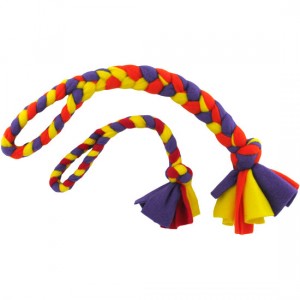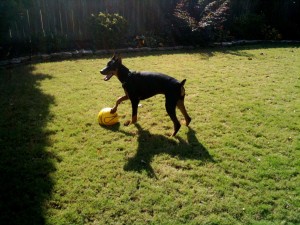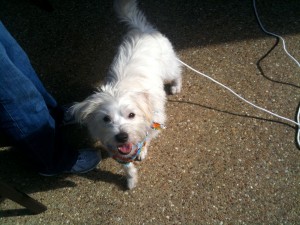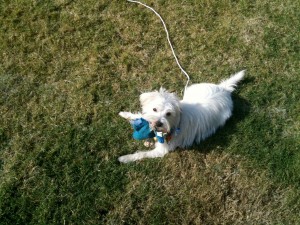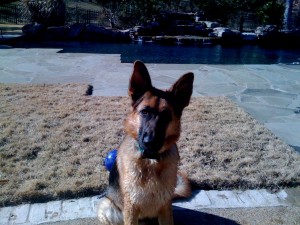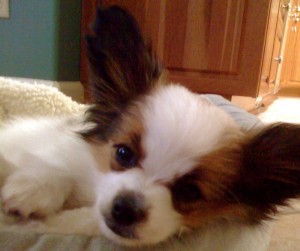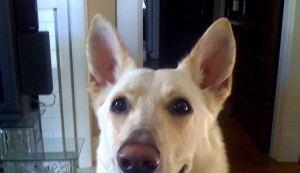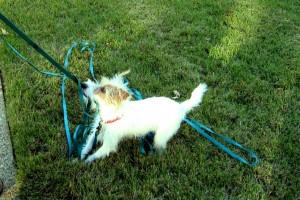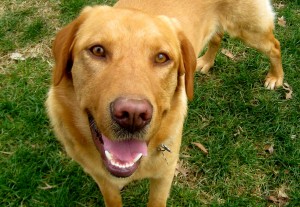Play-biting occurs when some of these normal, play behaviors are directed at human body parts and human clothing. Play biting is a stage of development. All puppies play bite, some more than others. Puppies mature and grow out of the play biting stage.
Puppies that play bite after 6 months of age are treating their humans like puppy play mates.
I categorize play-biters by placing them into one of two Groups. This is because some tips work well with 10 week old pups, but fail miserably with 6 month old pups.
If the pup is 8-16 weeks old, I automatically place them into Group A, the group of puppies that is learning about play-biting and making progress.
Play biting by these younger pups is normal and can usually be easily reduced, assuming the humans follow some guidelines. If their humans are consistent, young pups rarely graduate to Group B.
Group B pups are puppies 6 months and older that are still play-biting. Pups at 17-24 weeks could be in either Group A or Group B.
Pups in Group B are likely to exhibit other annoying behaviors such as jumping up, mounting, attention-barking, counter-surfing, mouthing and more.
There’s no shame if your dog falls into Group B.
There is so much inaccurate, contradicting information about dog training. Everyone you meet is an “expert”. It’s all too easy to follow the wrong advice. I know I did! Give yourself a huge pat on the back for finding this accurate resource.
The concepts for reducing play-biting, mounting, and mouthing are pretty much the same as the concepts for reducing most unwanted behaviors. There are several actions to consider.
Change Your Behavior
Few (including myself) can resist the soft cuddly fur of a puppy. I firmly believe that puppy tumble therapy is a marketable service. The buyer enters a room with several 7-10 week old puppies, gets on the floor and just soaks up puppy-glee by touching, tumbling and interacting with the puppies. I can’t imagine how such interactions would not be helpful for stress relief. I’d pay for the opportunity. Wouldn’t you?
Most people’s ideas of playing with puppies involve tumbling and rough handling.
Aren’t handling, pushing, wrestling, poking, teasing, tumbling, hugging, holding, cuddling, rolling, and chasing all good clean fun methods to interact with puppies? Fun? . . . yes; helpful for teaching a puppy? . . . no.
Expect to be bitten if you get on the floor and play wrestle, hug, manipulate, or otherwise use your hands to roughly interact with your puppy.
All these behaviors give puppies the impressions that we are just like their canine playmates. Puppies play rough with other puppies. At some point, puppy handling morphs into miscommunications which morph into playful puppy attacks! Ouch, those needle teeth are sharp!
It would be difficult for me to estimate how often I’ve heard this phrase.
“My child used to love the puppy but now she’s afraid of him. He randomly jumps up on her, steals her toys, mouths her arms, and nips at her heels and clothing. Sometimes he even knocks her down”.
When you think about it, these behaviors are in the same class of behaviors dogs exhibit while playing with other dogs.
The first step to resolve these issues is prevention. Attach a leash or long line so that your pup cannot mug your child.
Children and untrained dogs do not make choices which promote safe play. It’s best to supervise all interactions between children and animals.
Set aside time each day to introduce your child and your pup to safe games like fetch or hide-n-seek.
Sit-for-treat, roll over, and adult-accompanied, leashed walks are examples of other safe activities children can play with pups.
Nothing increases behaviors better than rewards! Establish reward systems for your child and your pup. Pay your child and your pup for playing nicely.
Other Preventative Measures
Ok, I’ll ease up on the lecture. Regardless of your perfect behaviors, your pup will play bite. That’s what they do. Here are some tips to help you survive this period.
Group A: 8-16 Week Old Puppies
- Tie a stuffed toy on a 10-12 foot line. (I use ¼ inch diameter nylon line I purchased at the hardware store.) Drag the toy when you walk. Praise the pup for attacking the toy instead of your ankles and feet!
- Sometimes you just want to handle your pup. Before you start grooming or handling, get a decoy. I use a Kong® toy stuffed with a bit of peanut butter. Hold the Kong® and let your pup get engrossed in the treat while you perform grooming or necessary inspections. Free Range Bullie sticks are also great decoys.
- Pay your pup for chewing the correct items. Deliver a treat and praise when he is engaged in wanted behaviors. Remember, when you increase appropriate behaviors, the inappropriate behaviors decrease in frequency!
- Use decoys when your child wants to stroke your pup. Choose periods when your pup is less active for stroking.
- Avoid sudden hand movements, especially movements near your pup’s face and head.
- Avoid pats on top of the head. Stroke your pup under his neck and south of the collar instead.
- Use long gentle strokes instead of short, harsh pats.
- Harvest some of that puppy-fur therapy when your pup is asleep!
Interrupt — Redirect — Pay
The Play-biting period is an educational journey for our pups. This is when they learn about bite inhibition and jaw pressure.
Pups that learn about jaw pressure and bite inhibition are less likely to deliver deep puncture wounds as adults.
Puppies learn about bite inhibition as they play with other puppies.
Here’s how a puppy learns from his littermates. When one pup bites another too hard, the recipient will yelp and withdraw.
This provides the play biter with valuable information about jaw pressure and contributes to the development of excellent bite inhibition.
This education from siblings and parents takes place early in a pup’s life.
Pups that are removed from their littermates before 8-9 weeks (or pups that are an only child) are at a greater risk for exhibiting more extreme versions of play biting.
Teaching puppies about jaw pressure reduces the probability of them delivering dangerous bites as adolescents and adults.
Ouch – Withdraw Method
Adults can continue the education process by following the following sequence. (This is not for children nor is it how to address play biting by Group B pups, which have already perfected their naughty behaviors!)
At this point we have two goals. Our short term goal is to teach the pup about jaw pressure. Our long term goal is to teach the pup that teeth-on-skin is unacceptable.
- When your young puppy play-bites, allow it. The instant you feel those needle teeth sting, speak a high-pitched “ouch” and immediately withdraw. Walk away and ignore your pup.
- If your pup becomes more excited after the “ouch”, follows you or bites your ankles, try this. Attach a leash and tether the pup to a piece of furniture. Now he can’t follow.
- Ignore your pup for several seconds while you review your behavior. Are you sending the wrong signals? Are you somehow enticing the pup to bite?
- Reengage by redirecting your pup to interact with a decoy.
- Praise your pup for chewing the item.
- Repeat the sequence several times in succession. Pups learn by repetition. It may take a week or more of using this sequence before your pup catches on.
In some cases, the “ouch” and withdrawal method is a slow process. Here are factors to consider.
- If a confident puppy has practiced and has refined play-biting as a normal method to interact with people, it will take more repetitions before the puppy will understand. Keep at it and you will succeed.
- If the pup is not offended by your departure, then withdrawing will not be effective.
- If family members are inconsistent, then the puppy will continue to play bite.
- If the puppy is older than 12-14 weeks, the ouch method will probably be ineffective.
- Failure could be a sign that the pup’s physical and mental exercise needs are not being met.
Sometimes it’s difficult to interrupt and redirect. The puppy seems to be out of control and will not listen.
This pup either needs more exercise or a nap. If excessive activities such as play-biting occur late in the evening, the pup may be ready for bed. If it occurs after the pup is well rested, then perhaps it’s time for some exercise!
In some cases, (especially in families with unwilling ‘ouch-withdraw” participants), I find it necessary to focus solely on teaching the pup to interact with appropriate items.
To encourage a pup, hold a decoy for your pup to investigate. When your pup touches it with his teeth or tongue, say “yes” to mark that instant of success.
Immediately deliver praise and/or a treat. After the pup catches onto the game, methodically extend the amount of time the pup must interact with the item before you mark success and deliver praise.
Group B: Puppies 6 Months and Older
Group B dogs are usually much larger (than Group A pups) and some of their newness has worn off.
Group B dogs have perfected play biting as a method to communicate with humans.
Because the dogs are older and families have yet to teach the dogs about play-biting, it is very likely that the family has unknowingly increased other obnoxious behaviors such as jumping up, nipping at clothes, attention-barking, object stealing, et cetera.
Group B dogs are at risk for being mistreated. Group B dogs are a bit closer to being sequestered into isolation or re-homed.
All of the preventative methods are effective with Group B dogs. In addition, you will need some management tools to control these larger dogs.
- Kindly prevent the dog from practicing play biting.
- Start a training program. Use kind methods to teach the dog basic obedience commands.
- If your Group B dog jumps up and play bites, attach a leash. Step on the leash to prevent the dog from succeeding. Use a buckle collar for this exercise.
- Correct and careful use of a head collar provides some families relief from the obnoxious behaviors of some Group B dogs. Check with your veterinarian or trainer for information about head collars.
What Not to Do
If you’re reading this I’m guessing you’ve tried all the popular methods to stop play-biting.
Some suggest that you squirt a play biting pup with a water bottle, bop the dog on the nose, hold the muzzle shut, grab the puppy by the scruff, shout “No Bite” or even roll the pup over and hold him down. These are questionable solutions.
Some pups will learn by these corrections and others become anxious, confused, fearful, or more playful.
The water bottle is the only suggestion I might share – in very rare situations.
Ask any person whose adult dog is grumpy during mouth and muzzle inspections. “Say, did you hold your dog’s muzzle shut when he was a pup?”
These uncooperative patients learned long ago that hands approaching face equals discomfort.
If you are using corrections to teach your pup about play-biting, and it is still a problem, it’s time to change course! What you are doing is not working.
Another problem with suggesting these methods is that people naturally become focused on stopping unwanted behaviors instead of starting wanted behaviors. This places them on a path of miscommunication with their pups. How will most people respond when the corrections are ineffective … when the squirt bottle doesn’t work? . . .
People naturally respond with more force and harsher punishers.
Some pups will stop play biting when harsher punishers are used. Of course these pups may stop coming when called, and start urinating in fear. DO NOT strike your puppy.
In addition, forceful techniques send messages to our children about resolving problems with force, when kinder, more efficient methods are available. Try the kind methods. You’ll be surprised how well they work!
Some people, (far be it from me to single out a specific gender or age group) believe that rough play teaches pups to be good protectors.
I have some experience teaching protection dogs. I have full exposure to the techniques and exercises. None of the professional, protection dog trainers I have worked with use rough play as a method to teach a dog to protect.
If any of the members in your pup’s circle of humans, insist on playing rough, expect your puppy’s play biting to continue or increase.
Play wrestling teaches puppies that rough play is ok.
In addition, games which include jumping up not only increase inappropriate jumping up, but can compromise a growing pup’s bone development.
People rarely eliminate play biting in a few days, because play biting is a normal stage for puppies. If you follow these suggestions, you can minimize play-biting during this period and prevent it from becoming a true problem in an older dog.
If your pup’s play biting is increasing in frequency or magnitude, contact your veterinarian for the name of a trainer or visit http://apdt.com and search for a trainer near you.
Happy Training!
Alan J Turner
Dog behavior counselor and trainer, Memphis, TN
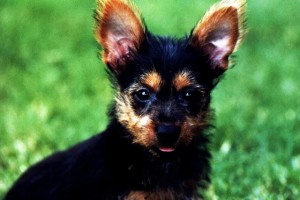
to visit Sit Stay and shop for tug toys.
